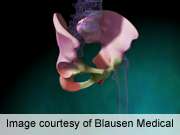Blood metal ions tied to failed hip replacement, resurfacing

(HealthDay)—Raised levels of blood metal ions are associated with failed metal-on-metal hip resurfacings and total hip arthroplasties, according to a study published in the July 2 issue of The Journal of Bone & Joint Surgery.
Alister J. Hart, M.D., from the Royal National Orthopaedic Hospital in London, and colleagues compared blood metal ion levels between a group of patients with failed implants and a group with non-failed implants. All 597 eligible patients had received unilateral Articular Surface Replacement prostheses at least twelve months earlier.
The researchers found that patients with failed arthroplasty had significantly higher blood cobalt and chromium ion levels than patients with non-failed arthroplasty (P < 0.01). Blood cobalt ion levels were disproportionately raised in patients with failed total hip arthroplasty versus patients with failed hip resurfacing (8.2 µg/L versus 2.5 µg/L; P = 0.018); however, blood chromium ion levels were not significantly different between the groups (P = 0.058). Using a 7-µg/L cutoff for either metal had a positive predictive value of 0.75 and a negative predictive value of 0.82. For each increase of 1 µg/L there was a 23 percent (P < 0.001) increase in the odds of patients with total hip arthroplasty being in the failed group and a 5 percent increased odds for patients with hip resurfacing (P < 0.001).
"No level had a perfect positive predictive value, and so we discourage surgeons from performing revision surgery based on blood metal ion levels alone," the authors write.
At least one author, or their institution, disclosed financial ties to an entity in the biomedical arena.
More information:
Abstract
Full Text (subscription or payment may be required)
Copyright © 2014 HealthDay. All rights reserved.

















